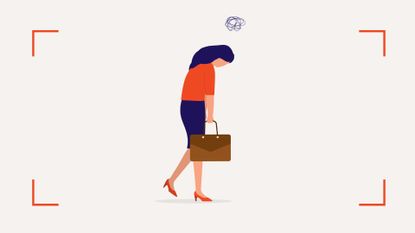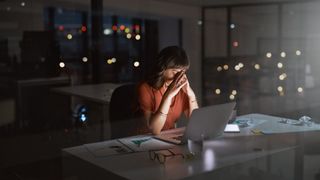I got burnout from work: Here's what no one tells you about chronic stress and how I recovered
Caitlin Wilde's burnout from work made her mentally and physically ill - here's how she tackled the issue and what she wishes everyone knew


"Looking back, I pretty much had it twice before it hit me full force," says Caitlin Wilde, whose name has been changed for privacy reasons, as she ruminates on her experience with burnout from work.
Burnout, as defined by the World Health Organisation (WHO) when they officially made the condition a diagnosis in 2019, is an "occupational phenomenon" that results from ongoing, unmanaged, and chronic workplace stress. It's this definition that's perhaps led to some confusion over what burnout from work can look like - and who can experience it.
Here, Wilde shares her honest experience of burnout from work with woman&home - the unexpected reality of chronic stress, what worked to help her learn how to recover from burnout, and what really didn't.
What I learned about burnout from work
Caitlin Wilde spent decades of her professional life working in the arts sector, which culminated in a high-powered, high-stress management role. In hindsight, she says, the ravages of burnout manifested in physical ways long before she considered the impact on her mental wellbeing.

1. Burnout manifests physically
A rather nasty case of repetitive strain injury (RSI) first indicated that all wasn't well. "The first time I really knew my stress was work-related was when I got RSI and that took a really long time to recover from," she tells us. "It was because of the stress in my body as well as the strain of so much computer work."
Wilde says the RSI was a wake-up call and alarm bells continued to sound after more physical illnesses made themselves evident. "I had another mystery kind of gut illness for about five or six weeks, and then it went away. But when that happened, it felt like a massive wake-up call," she says.
As poor gut health and anxiety are famously linked, along with other mental health issues, this was another red flag that meant she tried to be conscious of self-care. This meant trying the usual holistic options like yoga for beginners, meditation, and mindfulness. "I found myself having to do yoga twice a day and I'm not that kind of person. I've always been active, but I've never been in fitness. I think looking back, that was me grounding myself," she says.
Sign up for the woman&home newsletter
Sign up to our free daily email for the latest royal and entertainment news, interesting opinion, expert advice on styling and beauty trends, and no-nonsense guides to the health and wellness questions you want answered.
2. Exercise doesn't work as a cure for burnout
As the pandemic hit, Wilde joined the rest of the UK in taking on celebrity personal trainer Joe Wick's fitness videos. However, as she later learned, this was doing more harm than good.
While exercise is proven to have many benefits for our physical and mental health, with research from the University of Chicago suggesting that regular exercise can protect against the negative signs of high cortisol in women, it isn't the cure-all it's often set up to be when it comes to burnout specifically, thanks to the surging levels of adrenaline and cortisol that come with high-intensity exercise.
"I'm not saying that I would never do it again or that people shouldn't do it, it's just something to be aware of," she says. "You think you're letting out your stress but you're actually raising those levels."

3. Anyone can suffer from burnout
With the pandemic raging on, Wilde was dealt an additional pressure - losing the majority of her team to furlough. Her workload increased exponentially and it was this, she says, that was the tipping point into full burnout.
"We furloughed almost everyone at work and five of us were left to hold the whole organization together. All my colleagues from my team that were furloughed, I had their work and the director resigned. It was a chaotic, badly managed nightmare. It was already very stressful [before the pandemic] and it was left with us to try and somehow hold the organization together, separately working from our bedrooms."
This additional pressure was the final straw for Wilde, triggering the second round of burnout that brought things crashing down. "My brain stopped working, and I didn't know what was going on," she says.
Initially, Wilde wondered if she was in the grip of depression, something she'd experienced before because she couldn't stop crying. However, something about this time just felt different. "It didn't feel the same. I couldn't prioritize anything, I couldn't make a decision. I didn't trust myself, because I couldn't. I could feel that my brain wasn't working properly."
She considered herself "stressed and depressed", which considering her later diagnosis is understandable, as it's easy to confuse stress vs burnout. In the end, it was actually Wilde's mother that suggests the symptoms had more in common with burnout - something that Wilde just couldn't believe.

She couldn't even imagine that a woman like her, working in the arts, in a so-called 'nice job', with a good life, a good family, and good friends could suffer from emotional burnout from work. "I was like, 'I know that's not me. That's people who are doctors or soldiers, or high-powered execs.'"
But she started looking into it after the suggestion. "It just totally rang true and once I named it, that was the first step in feeling a bit better. Knowing that was what it was."
Having a name for how she felt was, despite being a devastating realization, in its way a relief because now she was ready to tackle the issue of how to deal with the condition in the long term. For Wilde, getting a formal diagnosis and acknowledgment from medical professionals felt vital and after a visit to her doctor, she was signed off from work.
4. Burnout causes physical changes to the brain
Diagnosis in hand, Wilde began to explore the condition. "When I found that [burnout is] actual brain damage, I was really horrified. Your prefrontal cortex actually shrinks, and it takes time to build back up again," she says, pointing to the increasing neuroscientific evidence indicating this frightening truth.
It's something that Professor Amy Arnsten of Yale University has researched extensively. "One of the most striking effects [of burnout] is thinning of the grey matter of an area of the brain called the prefrontal cortex," she told CNN. "[This part of the brain] helps us to act appropriately. It gives us insight about ourselves and others. It gives us perspective. It allows us to do complex decision-making and to be able to have thoughtful, abstract reasoning rather than concrete or habitual responses."
Once Wilde discovered the effect of burnout on the brain, she began to research burnout from work and learned more about what it was that she was facing. "I learned a hell of a lot doing that," she adds, crediting FRIED - The Burnout Podcast as a must-listen for anybody seeking knowledge and first-hand stories of people suffering from burnout.
How I recovered from burnout
1. Time away from work
Initially, Wilde was signed off from work by her doctor for a week but that soon turned into a month of not working - which she found was vital to deal with work-related burnout. "My brain wasn't working properly. I couldn't read, I wasn't doing my art practice, I couldn't face being at a computer," she explains. "I think getting a doctor's report to get some time off work is absolutely essential because otherwise you just come back with another illness. You're getting over it and you think you could do a bit of work but actually, your brain will just cut out. You have to have some time, your brain needs to recover."

In Wilde's case, this rest period meant that she was able to reconnect with her physical and mental wellbeing and disconnect from work. Although experts including Arnsten and those who are lucky enough to get through burnout from work, assert that you need time off, Wilde points out that taking long periods off work is a luxury afforded to few. "Not everyone has the luxury of being able to have a month of work, so it's really hard to advise on it." So there are other activities you can do instead, to try and lessen the risk of habitual burnout.
2. Reconnecting via grounding exercises
"I think burnout is partly from living in your head too much or not being embodied," says Wilde. In hindsight, she believes that engaging in more self-care before she even realized she was suffering from burnout was an instinctive way of grounding herself. Changing from cortisol-increasing HIIT training to focussing on LISS cardio like walking, as well as increasing her yoga, meditation, and mindfulness sessions were all examples of ground exercises - activities you can do to bring yourself more into the present moment.
"I think looking back, that was me grounding myself and that some of those things are quite healing for the brain as well. Those sorts of calming grounding exercises were the prescription I gave myself."
A huge part of tackling burnout from work isn't just treatment, it's prevention and identifying red flags - which brought Wilde to the next part of her recovery.

3. Working with a specialist burnout coach
"I worked over three months with the coach. We had an appointment every two months with lots of tasks in between," she says. For Wilde, those tasks were really helpful in picking up the amber flags of burning out before they went red. One of those amber flags, despite efforts to try and avoid burnout without quitting, turned out to be returning to her job.
"I had just recovered enough to cope," she says, "I couldn't see it improving. I thought it might've been a good job in 10 years time, but I'd be 60 by then." So, she decided that she wasn't going to wait around for something that didn't work anymore.
4. Maintaining boundaries
As a result of giving up her job and focusing on other passions, Wilde felt the final light switches coming back on. She found more time for her art practice and this, paired with a role in an entirely new industry that offered challenges while allowing for firm work/life balance boundaries, has helped her remain in recovery from burnout. While maintaining awareness and strong self-care practices have helped her avoid slipping back into the void if and when those feelings begin to bubble back up again.
Burnout is an extremely serious issue, Wilde stresses, and only by learning the signs can you prevent burnout from work before it really takes hold. "It's a systemic and environmental issue affecting people in all industries," she warns.
If you think you are suffering from burnout, visit your doctor. They'll be able to offer help with recovery and avoiding chronic stress in the future. For other resources on mental health, visit the National Alliance on Mental Health (US) or Mind Charity (UK).

Aoife is an Irish journalist and writer with a background in creative writing, comedy, and TV production.
Formerly woman&home's junior news editor and a contributing writer at Bustle, her words can be found in the Metro, Huffpost, Delicious, Imperica and EVOKE.
Her poetry features in the Queer Life, Queer Love anthology.
Outside of work you might bump into her at a garden center, charity shop, yoga studio, lifting heavy weights, or (most likely) supping/eating some sort of delicious drink/meal.
-
 Sarah Raven shares her savvy idea for embracing the 'second tree' trend on a budget this Christmas
Sarah Raven shares her savvy idea for embracing the 'second tree' trend on a budget this ChristmasThis sustainable DIY idea brings just as much festivity to your home without taking up all the space
By Emily Smith Published
-
 10 essential styling tips to get your dining room ready to host this Christmas
10 essential styling tips to get your dining room ready to host this ChristmasPrepare your dining room for a wonderful (and easy) Christmas with these top tips
By Katie Sims Published